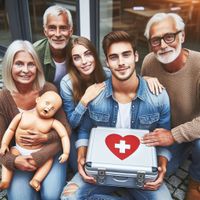scenario planning
Scenario 1: Regularly Practice Role-playing in Your Daily Life
Integrate these role-playing exercises into your daily routine and environments such as at home (house or apartment), in the garden, etc. This helps to demonstrate the impact of myopia, Long Covid, and ME/CFS on emergency response.
Our goal should be to raise awareness and constantly develop practical solutions.
Simulate an emergency situation, such as a fire alarm at home and the need to quickly find the nearest exit. Identify signs and instructions, and practice reading them under challenging conditions.
Scenario 2: Conduct Family Emergency Drills
Develop your own programs and ideas, involving the entire family in preventive emergency drills (with a special focus on family members with myopia, Long Covid, and ME/CFS). This not only improves the family's responsiveness but also fosters mutual support. The key is to regularly conduct evacuation drills at home to ensure all family members know what to do in an emergency.
Plan and carry out various evacuation drills (such as fire, earthquake, flood, heavy rain) at home, involving all family members. Conduct role-playing where everyone takes on a specific role and plays through different scenarios. Develop EMERGENCY plans together that consider the specific needs of people with myopia, Long Covid, and ME/CFS within your family, friends, and acquaintances. Thoroughly analyze the specific needs of all family members. Ensure that all necessary visual aids (glasses, contact lenses) are easily accessible and always within reach. Also, practice at night to ensure everyone can navigate in the dark.
Please also pack an emergency backpack with spare glasses, contact lens solutions, and other necessary aids.
Also create easy-to-read informational materials and plans that are clear and understandable for everyone. Consider using technologies like QR codes that link to emergency information and contact lists, along with apps that provide visual support.
Ensure that all escape routes are clearly marked and free of obstacles.
Define a safe meeting point outside your house/apartment where everyone can gather.
It may sound basic, but practice giving and understanding clear, simple instructions. Develop a system of hand signals and audio cues to support your communication. Also make use of technologies like walkie-talkies or special emergency apps that offer visual and auditory signals. If possible, install alarm systems with loud sounds and flashing lights to ensure everyone is alerted.
Use visual aids such as high-contrast markings and illuminated escape routes.
Place tactile cues like ropes or handrails along escape routes to better support individuals with impaired vision.
Organize community drills with neighbors, friends, and acquaintances to expand and strengthen your support network. Share your experiences and tips for emergency preparedness and response with others.
And if you want to put the finishing touch on all this, you could definitely consider interactive workshops with experts. Optometrists and emergency managers could hold joint training sessions to provide an optimal combination of eye health expertise and disaster preparedness, for example, fitting and adjusting visual aids in highly stressful situations, or presenting the latest research findings on myopia, Long Covid, and ME/CFS and their management in emergencies. This could also sharpen the inclusion of such topics in disaster preparedness programs of organizations like the Red Cross or local disaster management authorities.
A Few Realistic Scenarios for Night Drills
Scenario 1: Fire Alarm in the House at Night
Roles
Parent 1: Coordinator and Leader
Parent 2: Assists children and elderly persons
Child 1: Younger child
Child 2: Older child (e.g., with myopia)
Grandparent: Elderly person (e.g., with myopia)
Procedure: Trigger the fire alarm. Simulate a fire alarm that suddenly goes off at night.
Let's start ...
- Everyone takes on their role
- Parent 1: Leads the family to the safe meeting point
- Parent 2: Helps the children and the elderly person
- Children: Follow instructions and support each other
- Grandparent and older child (both e.g., with myopia): Use visual aids and tactile cues to safely reach the meeting point
- Practice escaping using different predetermined routes to ensure all paths are clear and safe
- Don't forget to discuss afterward what worked well and where improvements are needed
The scenarios also apply to Long Covid and CFS.
Scenario 2: Earthquake at Night
Roles:
- Parent: Safety Officer
- Child: Student
- Grandparent: Elderly person with, for example, myopia
Procedure:
- Create a realistic earthquake scenario where the house "shakes." This can be easily simulated with vibrations or sounds.
- All family members quickly move to the safest places in the house (under sturdy furniture and away from windows).
- The parent checks for safety and gives appropriate evacuation instructions.
- The evacuation takes place in the dark, meaning the family leaves the house using predetermined escape routes with limited lighting.
- Everyone gathers at the prearranged safe meeting point and a headcount is conducted.
- Don't forget the important post-drill analysis to review reactions and identify possible improvements.
Scenario 3: Conduct an "Emergency Hike"
Organize a hike where various emergency situations are simulated outdoors. Train in orientation and reacting to dangers in unfamiliar environments.
This is a great opportunity to learn how to avoid dangers in rough terrain (always considering safety, under adult supervision and monitoring), how to react to animals, and much more. It's a wonderful way to practice using maps and a compass, i.e., navigating with a special focus on the readability of visual information.
Here you can find our tips for visual aids
Check out our prevention tips here
Explore a potential expansion of our disaster preparedness portfolio - "Eyes" theme
Strong Together - Well Prepared Together - Resilient Together
Gemeinsam Stark - Gemeinsam gut vorbereitet - Gemeinsam Resilient
This contribution was written by Birgit Bortoluzzi, the creative founder of the “University of Hope” – an independent knowledge platform with a mission: to make resilience, education, and compassion visible and audible in a complex world.






